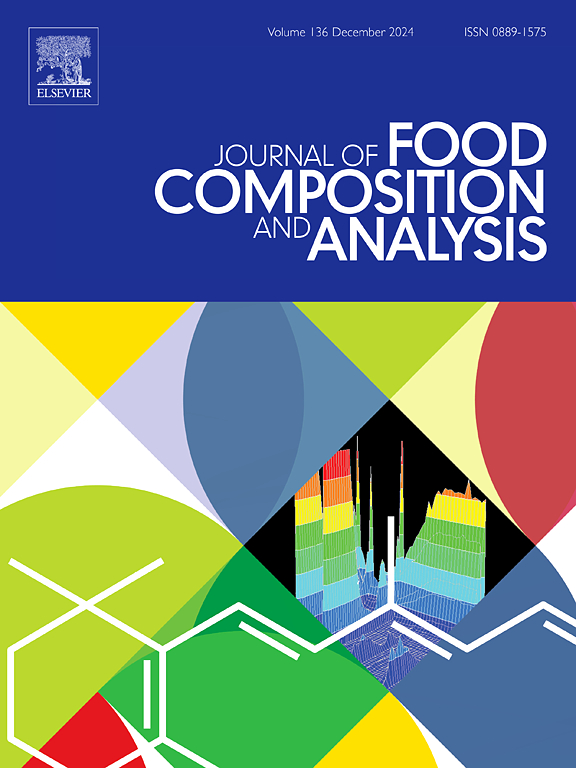Near-infrared reflectance spectroscopy (NIRS): An innovative, rapid, economical, easy and non-destructive whole grain analysis method for nutritional profiling of pearl millet genotypes
IF 4.6
2区 农林科学
Q2 CHEMISTRY, APPLIED
引用次数: 0
Abstract
Pearl millet, known for its nutritional excellence and climatic resilience, is becoming important in addressing food and nutritional security Current work introduces Near Infrared Spectroscopy models to estimate nutrients in pearl millet grains. The model is quick, economic and non-destructive alternative to traditional methods, useful in advancing the single plant progenies for improving nutrient content in segregating generations. Spectra were acquired from 403 varied genotypes, and mathematical optimizations using derivatives were performed to enhance the models. The optimal configurations were "2,36,6,2" (order of derivatives, gap, first smoothing and second smoothing, respectively) for amylose, "2,32,6,2" for starch, "2,32,8,2" for oil and protein, and "3,36,6,2" for phytic acid. The models were refined using modified partial least squares (MPLS) regression on spectra processed to eliminate variations with standard normal variate (SNV) and detrending (DT) techniques. The adjusted MPLS models exhibited impressive coefficients of determination of 0.985, 0.984, 0.986, 0.969 and 0.993 for amylose, protein, oil, starch and phytic acid, respectively. The SEP(C) values for amylose (0.347), starch (0.732), protein (0.313), phytic acid (0.014), and oil (0.162) suggest variable levels of predictive precision. Validation with independent samples showed superior predictive performance with coefficients of determination values ranging from 0.878 for phytic acid to 0.976 for protein, minimal bias, high ratios of prediction to deviation (2.93–5.81), and no significant differences between the predicted and reference values (p > 0.05). These advanced Near-Infrared Spectroscopy models allow quick and cost-effective nutritional assessment of pearl millet germplasm and breeding lines, supporting biofortification initiatives and enhancing nutritional security.
近红外反射光谱(NIRS):一种创新、快速、经济、简便、无损的全谷物珍珠粟基因型营养谱分析方法
珍珠粟以其优良的营养和气候适应性而闻名,在解决粮食和营养安全问题方面越来越重要,目前的工作引入了近红外光谱模型来估计珍珠粟籽粒中的营养成分。该模型是传统方法的一种快速、经济、无损的替代方法,可用于提高单株子代的营养含量和提高分离代的营养含量。从403个不同的基因型中获得光谱,并使用衍生物进行数学优化以增强模型。直链淀粉的最佳构型为“2,36,6,2”(衍生物的顺序、间隙、第一次平滑和第二次平滑),淀粉的最佳构型为“2,32,6,2”,油和蛋白质的最佳构型为“2,32,8,2”,植酸的最佳构型为“3,36,6,2”。利用修正的偏最小二乘(MPLS)回归对光谱进行改进,以消除标准正态变量(SNV)和去趋势(DT)技术的变化。调整后的MPLS模型对直链淀粉、蛋白质、油脂、淀粉和植酸的决定系数分别为0.985、0.984、0.986、0.969和0.993。直链淀粉(0.347)、淀粉(0.732)、蛋白质(0.313)、植酸(0.014)和油(0.162)的SEP(C)值显示出不同水平的预测精度。独立样本验证显示出较好的预测性能,植酸测定值的系数范围为0.878 ~ 0.976,偏倚最小,预测偏差比高(2.93 ~ 5.81),预测值与参考值无显著差异(p >; 0.05)。这些先进的近红外光谱模型允许对珍珠粟种质资源和育种品系进行快速和具有成本效益的营养评估,支持生物强化举措并提高营养安全。
本文章由计算机程序翻译,如有差异,请以英文原文为准。
求助全文
约1分钟内获得全文
求助全文
来源期刊

Journal of Food Composition and Analysis
工程技术-食品科技
CiteScore
6.20
自引率
11.60%
发文量
601
审稿时长
53 days
期刊介绍:
The Journal of Food Composition and Analysis publishes manuscripts on scientific aspects of data on the chemical composition of human foods, with particular emphasis on actual data on composition of foods; analytical methods; studies on the manipulation, storage, distribution and use of food composition data; and studies on the statistics, use and distribution of such data and data systems. The Journal''s basis is nutrient composition, with increasing emphasis on bioactive non-nutrient and anti-nutrient components. Papers must provide sufficient description of the food samples, analytical methods, quality control procedures and statistical treatments of the data to permit the end users of the food composition data to evaluate the appropriateness of such data in their projects.
The Journal does not publish papers on: microbiological compounds; sensory quality; aromatics/volatiles in food and wine; essential oils; organoleptic characteristics of food; physical properties; or clinical papers and pharmacology-related papers.
 求助内容:
求助内容: 应助结果提醒方式:
应助结果提醒方式:


